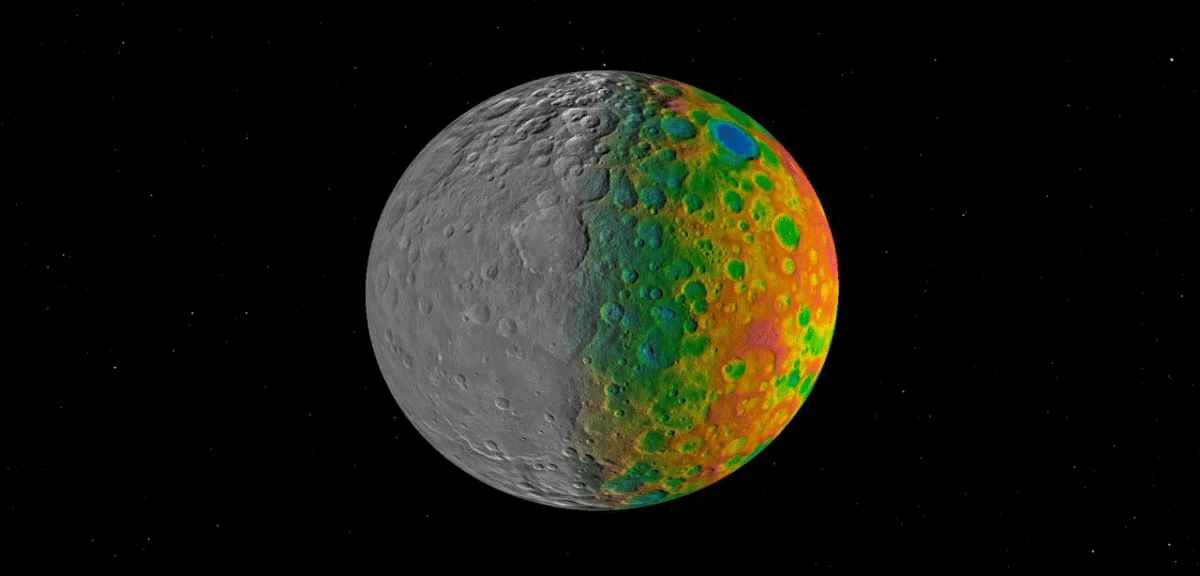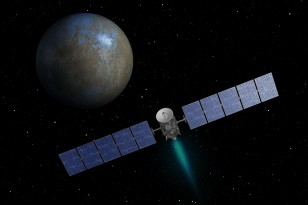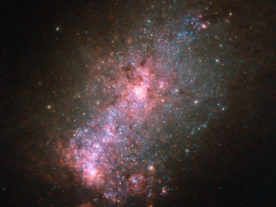
Scientists with NASA’s Dawn mission were surprised to find that Ceres has no clear signs of truly giant impact basins. This image shows both visible (left) and topographic (right) mapping data from Dawn. (NASA/JPL-Caltech/SwRI)
After NASA’s Dawn spacecraft had passed by the asteroid Vesta, on its way to rendezvous with Ceres, mission scientists noticed that its surface was banged up with a lot of very large craters. Its biggest impact crater is Rheasilvia, which measures 505 km in diameter.
They expected that Ceres would also be seriously pitted with giant impact basins too.
According to computer simulations of the geological history of Ceres, created by the Dawn scientists, the largest object in the asteroid belt, was supposed to have between 10 to 15 craters that were more than 400 km across and at least 40 craters at least 100 km wide.

NASA’s Dawn spacecraft photographed Vesta as it passed the dwarf planet on its trip to Ceres. (NASA/JPL-Caltech/UCAL/MPS/DLR/IDA)
After all, reasoned the scientists, it had to be hit a number of times by large asteroids over its some 4.5-billion-year history.
But after Dawn arrived at its destination back in March, 2015 the scientists were surprised to see that, unlike Vesta, Ceres didn’t have as many large craters as they expected.
The Dawn spacecraft revealed that Ceres has only 16 craters bigger than 97 km across and none were as large as its Kerwan basin, which is about 285 km wide.
Scientists used data gathered by Dawn to create more computer simulations.
According to a new study published in the journal Nature, these models are proposing that Ceres’ geology has undergone a significant evolutionary process, which could have rubbed out its big craters.
“We concluded that a significant population of large craters on Ceres has been obliterated beyond recognition over geological time scales, which is likely the result of Ceres’ peculiar composition and internal evolution,” said team leader Simone Marchi of the Southwest Research Institute in Boulder, Colorado in a press release.
While Ceres may not have the number of giant craters that was expected, the scientists did find, after continued study, that it has three huge “planitiae” or ground indentations that measure nearly 800 km across.
They suspect that the depressions may actually be the remains of big asteroid impacts.
Dawn science team member and planetary scientist David Williams from Arizona State University suspects several things may be behind the disappearance of big craters on the dwarf planet.
“If Ceres were highly rocky, we’d expect impact craters of all sizes to be preserved. Remote sensing from Earth, however, told us even before Dawn arrived that the crust of Ceres holds a significant fraction of ice in some form,” explained Williams.
He suggests that the crust of Ceres would become weak if it once held a good amount of ice which perhaps also mixed with salts.

An example of cryovolcanism are the ice volcanoes on Saturn’s moon Enceladus in this photo snapped by NASA’s Cassini spacecraft (NASA)
This weakening of the crust then would allow the structure of a large impact basin to relax to a point where it would become smooth and maybe even disappear.
Another way the large craters could have flattened or vanished may be due to heat that may have been generated beneath the dwarf planet’s surface soon after its formation by the decay of radioactive elements.
“Plus we do see evidence of cryovolcanism — icy volcanism — in the bright spots found scattered over Ceres, especially in Occator Crater,” adds Williams Cryovolcanism behaves like the rocky kind, only at much lower temperatures, where “molten ice” — water or brine — substitutes for molten rock.
Dawn’s scientists will continue to keep an eye on the dwarf planet when it when it makes its closest approach to the Sun in April 2018.
As it travels closer to the Sun, the Dawn science team wants to see if solar heat generates any odd behavior on Ceres or produces any noticeable changes to its surface.
























Errata: In paragraphs 2 and 3, delete “Vesta” and replace with “Ceres”.
Hi Mick,
Thanks so much for pointing out the mistakes in this piece! They have been corrected.
Regards,
Rick Pantaleo